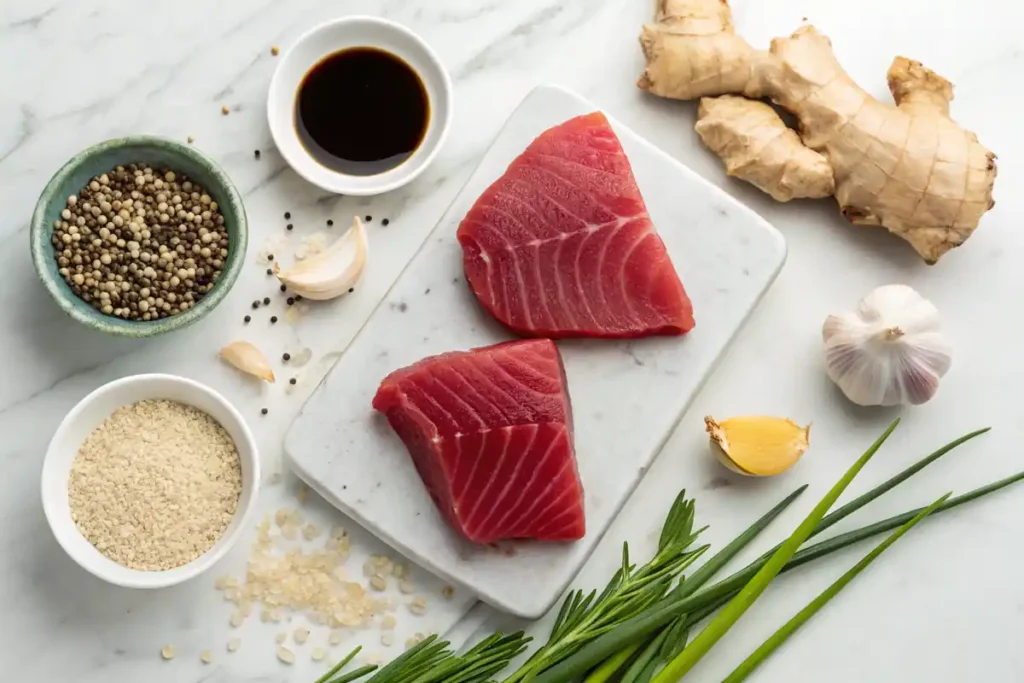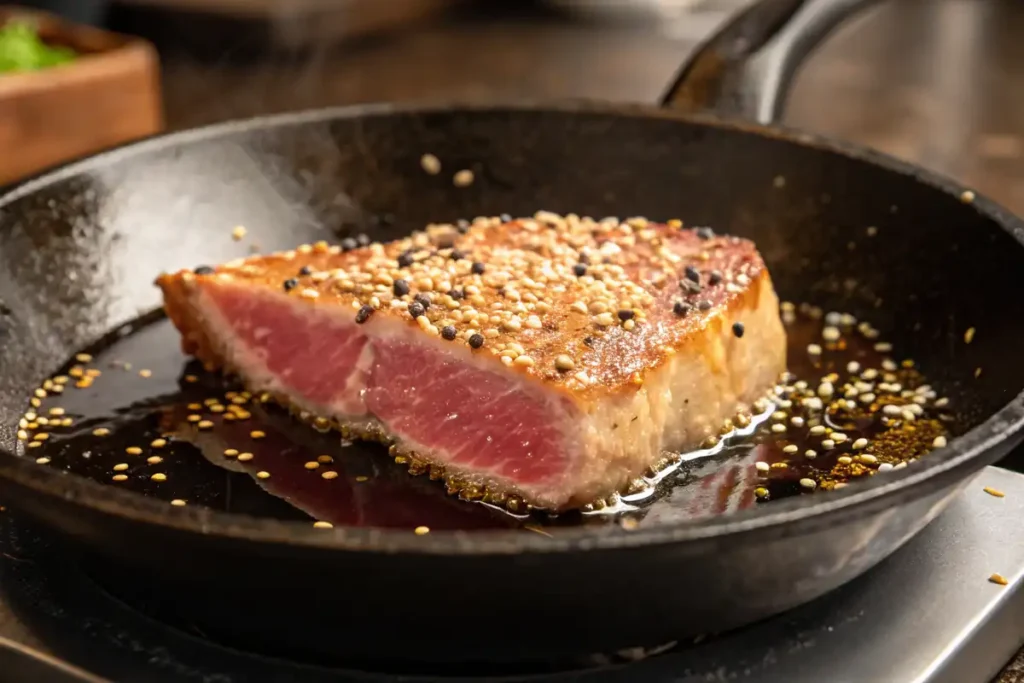Introduction
Seared ahi tuna is a culinary gem celebrated for its velvety texture, rich flavors, and impressive health benefits. Whether you’re a seasoned seafood lover or trying tuna for the first time, this dish offers a unique way to enjoy the delicate taste of fresh ahi tuna. In this article, we’ll explore everything you need to know about creating the perfect ahi tuna recipe – seared. From understanding its origins to mastering a fail-proof cooking technique, we’ll guide you step-by-step. Stick around for tips, nutritional info, and answers to your burning questions, ensuring your seared ahi tuna is nothing short of spectacular.
Introduction to Seared Ahi Tuna
What is Seared Ahi Tuna?
Seared ahi tuna is a dish that highlights the natural quality of fresh tuna by lightly cooking its exterior while leaving the center rare or medium-rare. The contrast between the crisp, flavorful crust and the tender, sashimi-like interior makes this dish a standout on any table. It’s quick to prepare, visually stunning, and utterly delicious.
Why Seared Ahi Tuna is a Favorite Dish?
There’s something magical about the way seared ahi tuna blends simplicity with sophistication. Its quick cooking time makes it a go-to choice for busy weeknights, yet its restaurant-quality appearance elevates it to gourmet status. It’s also a versatile dish, pairing beautifully with a variety of sides, sauces, and seasonings.
Overview of Cooking Methods for Ahi Tuna
Cooking ahi tuna is all about precision. While pan-searing is the most popular method, you can also grill or broil it for a similar effect. The key is to start with high-quality, sashimi-grade tuna and use a hot cooking surface to achieve a flavorful crust without overcooking the center. With the right technique, you’ll enjoy a dish that’s tender, juicy, and packed with natural flavors.
Based on the sitemap from Biteable Recipes, I did not find any directly relevant articles on ahi tuna or seafood recipes to include as internal links. However, if you would like, we can create placeholder links for future opportunities or explore other specific connections.
Understanding Ahi Tuna
What is Ahi Tuna?
Ahi tuna, also known as yellowfin or bigeye tuna, is a prized fish known for its tender, lean meat and mild flavor. Unlike regular tuna, ahi tuna is often served raw or lightly cooked due to its rich texture and sashimi-grade quality. This versatile seafood is perfect for dishes like poke bowls, sushi, and of course, the highly popular ahi tuna recipe – seared.
Yellowfin vs. Bigeye Tuna: Differences Explained
While both yellowfin and bigeye fall under the ahi category, there are subtle differences. Yellowfin tuna has a firmer texture and is commonly found in grocery stores, while bigeye has a higher fat content, making it more buttery and ideal for delicate dishes. Both are excellent choices for searing but ensure you source fresh, sushi-grade fish for the best results.
Sourcing High-Quality Ahi Tuna
Wild-Caught vs. Farmed: What to Know
Wild-caught ahi tuna is often considered superior due to its natural diet and flavor. Farmed tuna, while more consistent in size and availability, may have a slightly milder taste. Look for fish labeled as sashimi-grade to ensure it’s safe for rare preparation.
Sustainability and Ethical Practices
When purchasing ahi tuna, consider choosing sustainably sourced options. Overfishing has impacted tuna populations, so look for certifications like MSC (Marine Stewardship Council) or support local fisheries practicing ethical harvesting methods.
Benefits of Eating Ahi Tuna
Nutritional Advantages of Ahi Tuna
Ahi tuna is an excellent source of omega-3 fatty acids, which play a vital role in reducing inflammation and supporting heart health. For more details, check out this resource on omega-3 fatty acids from the National Institutes of Health (NIH).
Omega-3 Fatty Acids and Heart Health
The high levels of omega-3 fatty acids in ahi tuna are known to reduce inflammation, lower blood pressure, and decrease the risk of heart disease. Incorporating this fish into your diet is a flavorful way to support cardiovascular health.
Protein Power and Low Calories
For those looking to maintain a healthy weight or build muscle, ahi tuna is an excellent choice. It provides about 24 grams of protein per 100 grams, keeping you full and energized without adding unnecessary calories.
Rich in Vitamins and Minerals
Ahi tuna is loaded with essential nutrients like vitamin D, selenium, and magnesium, which support immunity, bone health, and energy production. Adding this nutrient-rich fish to your meals ensures a balanced and wholesome diet.
How to Prepare Seared Ahi Tuna
Essential Ingredients for the Perfect Recipe

Crafting the perfect ahi tuna recipe – seared begins with selecting the right ingredients. Using fresh, high-quality items ensures a flavorful and nutritious dish.
Fresh Ahi Tuna Steak
Look for sushi-grade tuna steaks, as they are safe for rare cooking. Ensure the fish is firm, smells clean (like the ocean, not fishy), and has a vibrant color. Aim for steaks that are about 1 to 1.5 inches thick for even cooking.
Must-Have Seasonings and Marinades
The beauty of seared ahi tuna lies in its simplicity. You’ll need ingredients like sesame oil, soy sauce, ginger, garlic, and sesame seeds to elevate its natural flavors. Optional spices like crushed red pepper flakes can add a kick, while citrus zest brightens the dish.
Step-by-Step Cooking Instructions
Follow these steps to achieve a perfectly seared ahi tuna steak:
Preparing the Tuna: Thawing and Cleaning
- If frozen, thaw the tuna steaks in the refrigerator overnight.
- Pat them dry with paper towels to remove excess moisture, which helps create a better sear.
Creating the Perfect Marinade
- In a shallow dish, whisk together 2 tablespoons of sesame oil, 1 tablespoon of soy sauce, 1 teaspoon of freshly grated ginger, and 1 teaspoon of minced garlic.
- Place the tuna steaks in the marinade, ensuring both sides are evenly coated. Let them marinate for 10–15 minutes at room temperature.
How to Achieve the Perfect Sear

- Heat a non-stick or cast-iron skillet over medium-high heat until it’s hot but not smoking.
- Add the tuna steaks to the pan, searing each side for 1–2 minutes for rare or 3 minutes for medium-rare.
- Sprinkle sesame seeds on the tuna steaks while cooking for a delightful crunch.
Tips for Plating and Presentation
Once cooked, let the tuna rest for 2 minutes before slicing thinly against the grain. Arrange the slices on a plate, garnish with scallions, and serve with your favorite dipping sauce or side dish.
Nutritional Information of Seared Ahi Tuna
Seared ahi tuna is not just delicious—it’s also incredibly nutritious. Knowing what you’re eating helps you make informed dietary choices, and this dish checks all the boxes for a healthy meal.
Nutritional Content (per 100g)
Below is the nutritional breakdown for ahi tuna recipe – seared:
| Nutrient | Amount |
|---|---|
| Calories | 130 |
| Protein | 24g |
| Fat | 4g |
| Omega-3 Fatty Acids | 1.5g |
| Carbohydrates | 1g |
| Iron | 1mg |
Why It’s a Healthy Choice
This dish is naturally low in calories and carbohydrates while being rich in protein and heart-healthy omega-3 fatty acids. It’s perfect for those looking to maintain a balanced diet without sacrificing flavor.
Note: I couldn’t find any directly relevant internal links on Biteable Recipes. However, for more culinary inspiration, explore the site’s Rockfish Recipes for other seafood ideas!
Pairing Ideas for Seared Ahi Tuna
Best Side Dishes for Ahi Tuna
Pairing the perfect sides with your ahi tuna recipe – seared enhances the dining experience by balancing its rich, delicate flavors. Here are some versatile options that complement the dish beautifully:
Rice Bowls
Steamed jasmine or basmati rice creates a neutral, fluffy base that soaks up the savory juices of seared ahi tuna. You can elevate it by adding a drizzle of soy-ginger sauce or serving it alongside seasoned sushi rice for a complete Asian-inspired meal.
Light Salads
A refreshing salad with mixed greens, cucumbers, and a tangy sesame vinaigrette offers a crisp, vibrant contrast to the richness of the tuna. Add avocado or mandarin oranges for a burst of creamy or citrusy flavor.
Steamed or Grilled Vegetables
Vegetables like asparagus, broccoli, or snap peas, lightly steamed or grilled, bring a healthy, textural element to your plate. Season them with garlic, sesame oil, or lemon juice for an easy yet flavorful pairing.
Sauces to Elevate Your Dish

The right sauce can make your ahi tuna recipe – seared even more memorable. These flavorful additions are quick to prepare and enhance the dish’s savory notes:
For a bold twist, consider serving seared ahi tuna with rich, creamy sauces like this Cajun Alfredo Recipe.
Wasabi Cream Sauce
Blend a dollop of wasabi paste with Greek yogurt or sour cream for a creamy, spicy kick. This sauce is a crowd-pleaser and works as a tangy topping or dipping option.
Soy Ginger Dipping Sauce
Combine soy sauce, fresh grated ginger, and a hint of honey or brown sugar for a sweet-savory dip that perfectly complements the tuna’s natural flavors. Sprinkle in sesame seeds for an added touch.
FAQs
To help you perfect your ahi tuna recipe – seared, here are answers to common questions:
How is ahi tuna best cooked?
Ahi tuna is best cooked quickly at high heat to preserve its tender, sashimi-like interior. For the perfect sear, aim to cook each side for 1–2 minutes, leaving the inside rare or medium-rare. Overcooking can dry out the fish, so keep a close eye on it!
How does Gordon Ramsay cook ahi tuna?
Renowned chef Gordon Ramsay recommends keeping it simple: season the fish lightly, sear it in a hot pan with olive or sesame oil, and allow it to rest before slicing. His method emphasizes the importance of fresh, high-quality tuna and minimal seasoning to let the natural flavors shine.
What is the difference between ahi tuna and regular tuna?
Ahi tuna refers specifically to two species: yellowfin and bigeye. These varieties have a richer, more buttery texture compared to regular canned tuna. Their quality makes them ideal for raw dishes like sushi or lightly cooked recipes like seared ahi tuna.
What seasonings are good on tuna?
Seasonings that enhance ahi tuna recipe – seared include sesame seeds, soy sauce, ginger, garlic, and a sprinkle of red pepper flakes. These ingredients bring out the fish’s natural umami flavor while adding a touch of spice and depth.

Ahi Tuna Recipe – Seared | The Ultimate Delicious Guide in 5 Steps
Ingredients
- 2 sushi-grade ahi tuna steaks 1 to 1.5 inches thick
- 2 tablespoons sesame oil
- 1 tablespoon soy sauce
- 1 teaspoon freshly grated ginger
- 1 teaspoon minced garlic
- 2 tablespoons sesame seeds
- 1/4 teaspoon crushed red pepper flakes optional
- scallions for garnish
Instructions
- If frozen, thaw the tuna steaks in the refrigerator overnight. Pat them dry with paper towels to remove excess moisture.
- In a shallow dish, whisk together 2 tablespoons of sesame oil, 1 tablespoon of soy sauce, 1 teaspoon of freshly grated ginger, and 1 teaspoon of minced garlic.
- Place the tuna steaks in the marinade, ensuring both sides are evenly coated. Let them marinate for 10–15 minutes at room temperature.
- Heat a non-stick or cast-iron skillet over medium-high heat until it’s hot but not smoking.
- Add the tuna steaks to the pan, searing each side for 1–2 minutes for rare or 3 minutes for medium-rare. Sprinkle sesame seeds on the tuna steaks while cooking for a delightful crunch.
- Once cooked, let the tuna rest for 2 minutes before slicing thinly against the grain. Arrange the slices on a plate, garnish with scallions, and serve with your favorite dipping sauce or side dish.
